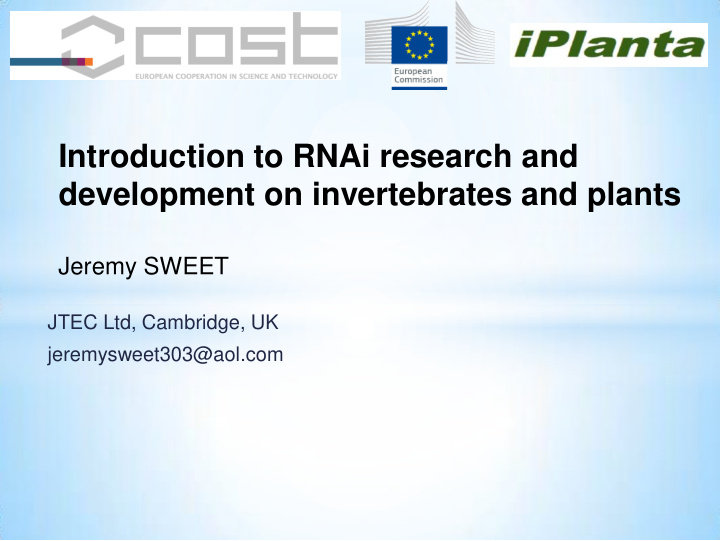



Introduction to RNAi research and development on invertebrates and plants Jeremy SWEET JTEC Ltd, Cambridge, UK jeremysweet303@aol.com
RNAi Research Invertebrate Studies : Drosophila and C.elegans used as model species have provided a huge amount of info for genomics studies which is relevant for human and animal health and for crop protection research. Research Foci : Human and Animal Health: incl. knock down of cancer cells/tissues, viruses, genetic disorders (Parkinsons) etc … Plant health: virus, disease & invertebrate pest control
RNAi for control of virus, fungal and bacterial pathogens in plants and animals Virus control examples : • Crustacea : shrimps, prawns • Gastropods : shell fish : oysters etc.. • Insects : e.g. Bombyx silk worm, Bees • Birds and Mammals : e.g. Avian flu • Plants : range of viruses in annual, herbaceous and woody plants . Particularly insect vectored viruses Bacteria and fungi in a range of animal and plant species e.g. Citrus Greening ( Candidatus spp), Fusarium ear blight in wheat
Time trend for plant-RNAi inventions Espacenet/EPO data
Patents: Plant RNAi Espacenet/EPO data
Research on Invertebrate Pest Control Mammalian pests : e.g. Mosquitos (Aedes, Anopheles) : -> . pesticide development Crop pests : Hemiptera, Homoptera, Coleoptora, Lepidoptera, Diptera, etc ….. Mites , Nematodes, Topical and oral exposure to mostly dsRNA, Potential for pesticide development Studies also include in-planta expression of interfering RNA targeting a wider range of pest species and genes.
GM plants expressing double stranded RNA (dsRNA) which interferes with various gene functions in plant or other organisms. Post transcriptional Gene Silencing: Examples: Change fatty acid profile in Soybean Modified starch Potato Controlling pests : e.g. Smartstax maize for corn root worm (Diabrotica) control . Silencing viruses : e.g. papaya ringspot, plum (Sharka virus)
INDUCING RNAi PLANT RESISTANCE WITH MODIFIED ROOTSTOCKS Non-Transgenic scion Non-Transgenic resistant fruits Transgenic rootstock Hairpin derived Transgenic plant siRNAs 21-nt and 24-nt Transfer of virus resistance from rootstock to scion
2 Activities in EU : COST Action CA15223 A PLANT RNAI RESEARCH NETWORK encourage interactions of researchers across 31 European and nearby countries with inputs from cooperating researchers in associated countries in N and S America, Australasia etc.. define and promote the most important research tasks for the development of novel RNAi transgenic strategies in Plants iPlanta runs from 2016 to 2020.
• The main activities include : • a) Evaluation of the efficacy of the RNA molecules for the induction of disease and pest resistance and metabolic changes in plants. • b) Examination of the specificity of the selected miRNAs and siRNAs and their impacts on both target and non-target/off- target systems. • c) Developing specific risk assessment and risk management guidelines which relate to specific effects of the miRNAs and siRNAs on food, feed and the environment. • d) Understanding the modes of transmission, uptake, systemic spread and degradation of dsRNAs, mi- and siRNAs. • f) Determining the environmental and socio-economic impacts of plant RNAi technology and products. • g) Communication through workshops, conferences and various media.
Main Messages from 1st conference in Rome 2/2017 Research requirements : the mechanisms of activity and methods of delivery of ds/siRNAs to targets. miRNA interactions with RNAi mechanisms application bottlenecks depending on whether the targets were in planta (i.e. viral or plant transcripts), or those in fungi, insects, nematodes etc. Environmental stability of dsRNA Non-target effects in related and unrelated exposed species and food chain effects Off target effects : role of bioinformatics and omics for food and environment RA.
2 nd Activity on RNAi in EU :
Published June 2017
Literature review of baseline information on RNAi that could support ERA of RNAi-based GM plants (OC/EFSA/GMO/2015/02) Olivier Christiaens 1 , Teodora Dzhambazova 2 , Kaloyan Kostov 2 , Salvatore Arpaia 3 , Isabella Urru 3 , Jeremy Sweet 4 and Guy Smagghe 1 1 University of Ghent, Belgium. 2 ABI, Sofia Bulgaria 3 ENEA, Italy 4 JT Environmental Consultants, Cambridge, UK FOCUS : RNA Interactions with invertebrates
REPORT SECTIONS : 1. Systematic Literature Search 1.1. Systematic search protocol and systematic literature search of relevant scientific publications. 1.2. The relevant scientific publications identified and entered into the Endnote data base 1.3. The activity spectrum of the tested dsRNAs, siRNAs and miRNAs 1.4. Oral introduction of siRNA and miRNA and the induction of efficient RNAi in arthropods, nematodes, annelids and molluscs. 2. Components and mechanisms of dsRNA, siRNA and miRNA uptake and systematic spread in arthropods, nematodes, annelids and molluscs 3. Environmental exposure and fate of dsRNA, siRNA and miRNA. 4. Factors influencing silencing efficiency of dsRNA, siRNA and miRNA delivered orally in arthropods, nematodes, annelids and molluscs 5. Off target, non-target and unintended effects of RNAi-based GM plants (including resistance development) 6. Genomic data on arthropods, nematodes, annelids and molluscs
Literature review of baseline information on RNAi that could support ERA of RNAi-based GM plants. Report Completion : December 2017 Presented to EFSA GMO Panel : January 2018 Publication ~ Feb/March 2018 Progress to date : Search designed and completed : c 14,000 papers -> c 5000 papers relevant -> data extracted - > reviews …….
RNAi studies in invertebrates
First EFSA report available on baseline molecular information on RNAi : http://onlinelibrary.wiley.com/doi/10.2903/sp.efsa.2017.EN- 1246/abstract
Future activities of iPlanta • Biosafety workshop with IOBC GMO meeting 6-7 September 2017 Ghent Belgium • RNAi Conference and workshops February 2018 Poznan Poland www. iplanta.univpm.it . • http://www.cost.eu/COST_Actions/ca/CA15223 • Facebook: COST iPlanta
Thankyou www. iplanta.univpm.it . jeremysweet303@aol.com
Recommend
More recommend